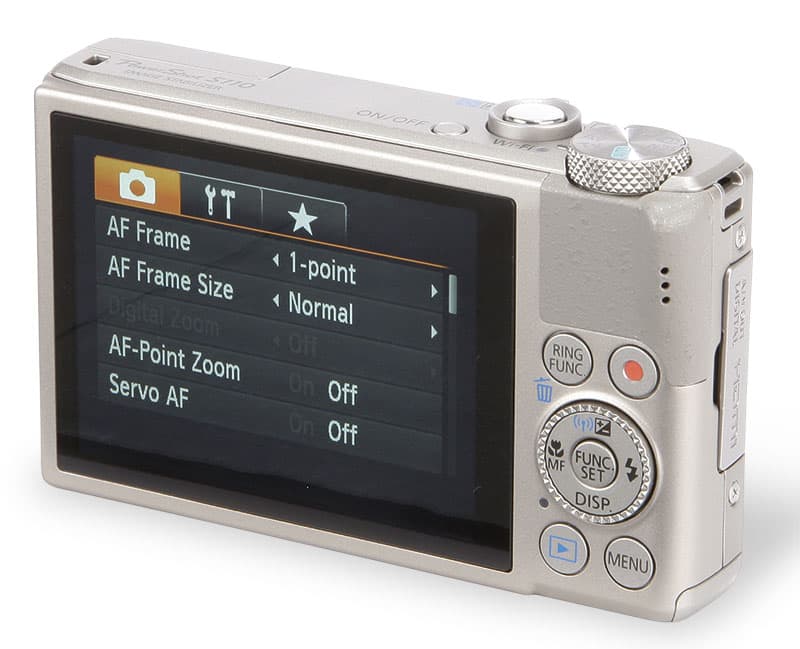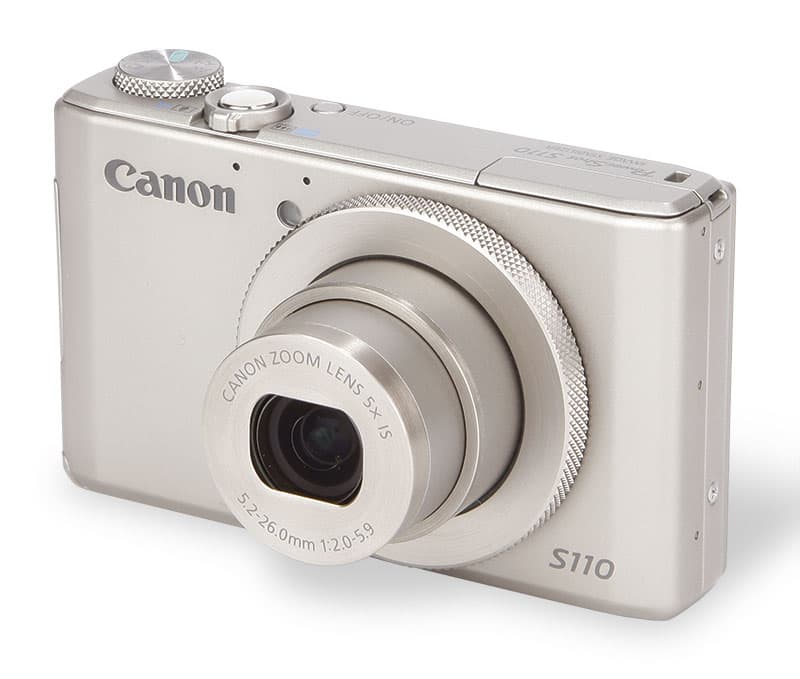Canon PowerShot S110 at a glance:
- 12.1-million-pixel CMOS sensor
- 24-120mm f/2-5.9 Canon lens
- Lens control ring
- Wi-Fi enabled
- 3in, 461,000-dot capacitive touchscreen
- Street price around £370
Canon PowerShot S110 review – Introduction
Alongside the PowerShot G15, the Canon PowerShot S110 sits at the top of Canon’s compact camera range. The G15 is the larger of the two, with numerous external controls, a viewfinder and hotshoe.
Despite its simpler design, the Canon Powershot S110 is packed with features and the sort of control expected from much larger cameras, namely raw capture and fully manual exposure control. It replaces the PowerShot S100 – which was reviewed in AP 3 December 2011 and scored 86% – as a modest but welcome refresh and here we highlight its key aspects and new features.

Canon PowerShot S110 review – Features
Like many high-end compacts, including its S100 predecessor, the Canon PowerShot S110 has a 1/1.7in (7.6×5.7mm) imaging sensor, resulting in a 4.55x focal-length magnification. The camera therefore requires a 5.2-26mm Canon lens to achieve the 24-120mm effective focal length. Like the S100, the S110 shoots raw and JPEG images, has a 12.1-million-pixel sensor and uses the same Digic 5 processor. However, it has a 1EV greater sensitivity range of ISO 80-12,800.
Whereas the S100 offers GPS to add location information to images, the S110 has Wi-Fi. This means the camera can wirelessly connect to another Wi-Fi camera, a computer or smartphone. Canon’s free CameraWindow app is required for use with a smartphone. It is available for iOS and Android operating systems, and is designed to allow users to view and share images from the camera. With Wi-Fi activated, the camera can also use the smartphone’s GPS. There is no remote shooting functionality through Wi-Fi, as there is in the Samsung EX2F, which is a shame because this would further enhance the S110’s handling.
Shooting modes are the same on both the S100 and S110, with the S110 offering HDR among a number of creative effects, a high-speed burst HQ scene mode that gives a 10fps burst and a continuous high drive mode of 2.2fps. Canon has enhanced the smart auto mode, which can now detect up to 58 scenes (rather than 32 scenes in the S100) to select the best auto setting. In day-to-day use, it is difficult to see the improvement that this brings.

Image: The camera has a good dynamic range. In this scene there is still discernible detail in the wall where sunlight is being reflected
Canon PowerShot S110 review – Build and handling

Image: The new touchscreen enables touch shutter, which can be linked to metering and AF. Here the exposure reading has been taken for the building
The Canon PowerShot S110 measures 98.8x59x26.9mm and weighs 198g, so the physical specifications of the S110 and the S100 are almost identical. The S110 is the smallest of the high-end compacts on the market, being almost half the size to some of its competitors.
The body shell is made from a tough polycarbonate. Wi-Fi functionality is indicated on the top-plate, with a blue light indicating when Wi-Fi is activated. Unsurprisingly, there is a major drain on the battery when Wi-Fi is turned on, so it is worth turning it off between shots. I found this a little more fiddly to do than doing the same with GPS.
Minor tweaks to the body include a differently shaped thumb rest, while the finish to the side of the shooting-mode dial is now a cross-hatch pattern, but otherwise the camera’s form is the same. The stabilised 24-120mm (equivalent) f/2-5.9 Canon lens is unchanged, too.

The one key difference in the handling of the S110 is the addition of a touchscreen and, apart from the Olympus XZ-2, there is currently no other high-end compact with this feature. The shutter and spot AF can be activated by touch anywhere in the frame, which is a key benefit of a touchscreen as it ensures that the subject is the point of focus.
Navigating some of the menus has been enhanced, too, via the lens control ring. This can be changed to adjust, among other things, any one of the shooting-mode values (such as aperture when in aperture priority), ISO, exposure compensation and focus. By pressing on the right-hand side of the touchscreen, the control-ring function can be temporarily changed to one of two other key settings. It’s a little fiddly at first, but it does enhance the handling of the camera.
Image: Touch focusing and metering quickly enable a change of exposure from the bright sky to meter for the people in the foreground
Canon PowerShot S110 review – LCD, viewfinder and video
Given the simple button layout of the Canon PowerShot S110, the new capacitive touchscreen, which is as sensitive as that found on a high-end smartphone, adds an extra dimension to the control and navigation. Its size, resolution and brightness remain the same, though, being a 3in, 461,000-dot TFT unit.
Canon PowerShot S110 review – Noise, resolution and sensitivity

These images show 72ppi (100% on a computer screen) sections of images of a resolution chart, captured with the lens set to 50mm and f/5.6. We show the section of the resolution chart where the camera starts to fail to reproduce the lines separately. The higher the number visible in these images, the better the camera’s detail resolution is at the specified sensitivity setting.
With the same sensor and pixel count, the performance of the Canon PowerShot S110 matches that of its predecessor.
The only difference is that the new camera offers a high ISO 12,800 setting. Resolved detail is therefore respectable.
However, other high-end compact cameras that have been released since the S100 have upped the bar concerning image quality, most notably the Sony Cyber-shot DSC-RX100. It is for this reason that the S110 scores 26 out of 30 rather than the 28 of its predecessor.
Canon PowerShot S110 review – Our verdict
The canon PowerShot S110 has the same scores as the S100 in build/handling, dynamic range, AWB/colour, metering, autofocus and LCD/viewfinder, with one extra mark for its features and a deduction of two points in noise, resolution and sensitivity because of the improvements of other high-end compact cameras over the past year. Image quality is good without being class-leading, being superseded by the Sony Cyber-shot DSC-RX100. The handling is excellent, though, and is even enhanced thanks to the reliable touchscreen. Wi-Fi makes image sharing easier, and hopefully next time remote shooting will be included.
Canon’s PowerShot S-series cameras may no longer be top of their class, but the S110 is a very capable camera that should find its way into the pocket of many photographers.







